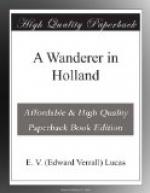Dou did exceedingly well, one of his patrons even paying him a yearly honorarium of a thousand florins for the privilege of having the refusal of each new picture. “The Poulterer’s Shop” at our National Gallery is a perfect example of his fastidious minuteness and charm. But he painted pictures also with a tenderer brush. I give on the opposite page a reproduction of the most charming picture by Gerard Dou that I know—“The Young Housekeeper” at The Hague. This is a very miracle of painting in every inch, and yet the pains that have been expended upon the cabbage and the fish are not for a moment disproportionate: the cabbage and the fish, for all their finish, remain subordinate and appropriate details. The picture is the picture of the mother and the children. “The Night School”—No. 795 in the Ryks Museum at Amsterdam—is, I believe, more generally admired, but “The Young Housekeeper” is the better. “The Night School” might be described as the work of a pocket Rembrandt; “The Young Housekeeper” is the work of an artist of rare individuality and sympathy. At the Wallace Collection may be seen a hermit by Dou quite in his best nocturnal manner.
Gerard Dou died at Leyden, where he had spent nearly all his quiet life, in 1676. He is buried at St. Peter’s, but his grave does not seem to be known there.
Dou had many imitators, some of whom studied under him. One of the chief was Godfried Schalcken of Dort, whose picture of an “Old Woman Scouring a Pan” may be seen in the National Gallery, while the Wallace Collection has several examples of his skill. Schalcken seems to have been a man of great brusquerie, if two stories told by Ireland of his sojourn in England are true. William III., for example, when sitting for his picture, with a candle in his hand, was suffered by Schalcken to burn his fingers. “One is at a loss,” says Ireland, “to determine which was most to blame, the monarch for want of feeling, or the painter of politeness. The following circumstance, however, will place the deficiency of the latter beyond controversy. A lady sitting for her portrait, who was more admired for a beautiful hand than a handsome face, after the head was finished, asked him if she should take off her glove, that he might insert the hand in the picture, to which he replied, he always painted the hands from those of his valet.” The most attractive picture by Schalcken that I have seen is a girl sewing by candle light, in the Wallace Collection. It pairs off with the charming little Gerard Dou at the Ryks—No. 796.
Dou said that the “Prince of his pupils” was Frans van Mieris of Delft, who combined the manner and predilections of his master with those of Terburg. He was very popular with collectors, but I do not experience any great joy in the presence of his work, which, with all its miraculous deftness, is yet lacking in personal feeling. Mieris, says Ireland, “was frequently paid a ducat per hour for his works.




